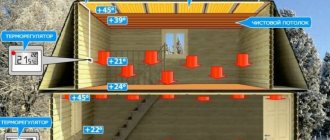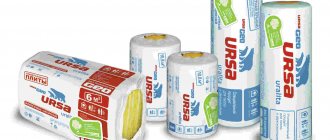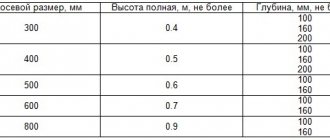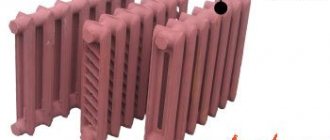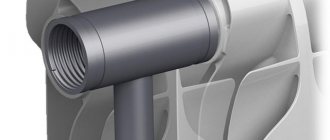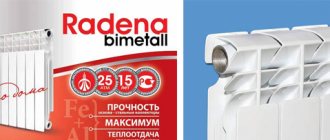The heating process using infrared radiation occurs due to its physical properties. Mainly such as reflectivity, absorption ability of various surfaces and substances, transmission, dispersion, etc. For example, air consists of nitrogen and oxygen molecules, almost does not absorb, but partially scatters and easily transmits such radiation. The human body, like any objects in the room, mostly absorbs electromagnetic waves from this part of the spectrum, only partially reflecting them.
The principle of heating using infrared radiation
In the process of infrared radiation, electromagnetic energy is transformed into thermal energy. Thus, any objects in the room, when heated, give off this energy to the air, as a result of which it is heated.
With infrared heating, conversion flows reduce their speed by an order of magnitude, and the rays, hitting the human body, activate its peripheral circulatory system, which causes thermal comfort 3-4 °C earlier than with conventional heating with convectors. Being the most useful part of the solar spectrum, the emitted rays compensate for the “solar hunger”.
That is, any heated object is a source of infrared radiation. The wavelength of such radiation is determined by the molecular composition and temperature of the object. The amount of energy received depends on this.
Another example of such heating is the Sun, which warms our Earth. This is the most powerful source in the solar system. The sun is its natural heater.
Everything living on Earth vitally needs solar warmth, and humanity is no exception. Infrared rays from the sun travel billions of kilometers through space with minimal loss. Any surface encountered on their path heats up, absorbing the energy of the rays and turning into heat.
Optimal selection criteria
Acting as an “earth-sun” model, the PLEN system, when installed in May or October, will simply maintain the thermal regime that the house was saturated with during the summer-spring period. This heater also works effectively in rooms with good thermal insulation.
This saves energy, and the heating can be turned off periodically. And less time will be spent heating the resistor film - a reduction of approximately 10% of the main time costs. The heating turns off once the space has reached the desired temperature. You will need to turn it on periodically and only for 3-15 minutes.
Infrared Heating Basics
Long waves are the most comfortable for people. Since the range of infrared radiation itself is quite large, scientists divided it into three subranges:
- Short - it is adjacent to the visible part of the world.
- Average.
- Long.
The hottest objects emit shorter wavelengths. The warmer the object, the shorter the wave.
PLEN heating is an alternative to the outdoor heating system used by nature.
The PLEN system, mounted on the ceiling, allows you to obtain thermal comfort in the same way that the Sun gives it to all living things. Long-wave radiant energy emitted by heating elements heats objects, floors, cars, which, in turn, accumulate it and then release it into the environment. At the same time, air humidity remains natural.
That is, the meaning of what has been said comes down to the fact that in order for the room to become warm, it is not at all necessary to heat the air in it.
Nuances of the installation process
It should be noted right away that the PLEN heating system is installed on foil insulation, which will not only create a thermal insulation layer, but also reflect emitted waves towards the room using foil. Therefore, the surface on which the heating film will be mounted must be covered, for example, with isolon.
Izolon must be placed under PLEN
Now, regarding the mounting of the heater itself. Everything will depend on what material it will be attached to.
- If it is wood, then the best option is metal staples and a stapler. In this case, you can use nails or wood screws.
- If it is concrete, then you will have to drill holes in it, insert plastic dowels into them, and screw screws into them through the film.
As for the principle of laying the film, first of all you need to decide in which direction the connection to the current supply will be located. The shorter the distance between the connection points, the less cables you will have to use for wiring. And this is savings.
Depending on the chosen model and size of the heater, its coverage area is determined. This indicator varies between 50÷100%, but 80% is considered optimal. A gap must be left between the film heater and the tension or suspended structures. The gap size is within 10÷15 cm. All work related to the connection is strictly carried out according to the electrical diagrams supplied with the PLEN.
Gap between PLEN and ceiling trim
Connection nuances
Depending on which voltage devices were selected, their own circuits are used:
- If films with a voltage of 220 V are selected, then they are connected to each other only in parallel.
- If 110 V devices are used with a connection to a 220 V network, then they are connected to each other in pairs. The latter are connected to each other in parallel.
- The same is with PLEN heaters with a voltage of 73 V. They are connected to each other in series, 3 pieces at a time.
That is, in any case, the output should be 220 V: 110 + 110 = 220; 73x3 = 219.
Correct connection of films to each other
Installing a thermostat
This device controls the indoor air temperature by turning the PLEN system off and on. There are three nuances to correctly installing a thermostat:
- It is embedded into the phase wire.
- The installation location is on the wall at a height of 150 cm. An important component is that the device must be installed on the internal wall, and not on the external one, which is in contact with the street. It is best to install it away from windows and doors so that the sun's rays do not fall on it.
- If the total load from the entire system exceeds 9 A, then the thermostat is connected through a special modular contactor. The latter simply reduces the load.
Attention! It is better to install the thermostat on a material with low thermal conductivity. For example, on a wooden plank that is attached to the wall.
Installing a thermostat
What is PLEN and how does it work?
PLEN stands for “film radiant electric heater.” This is an infrared heating system consisting of a resistive radiating element located between polymer films. The basis of the PLEN system is the interaction of infrared radiation with various matter and its physical properties.
It is called a resistive element because it consists of several layers of resistor circuits (resistances).
When PLEN heating is connected to the electrical network, an electric current begins to pass through the resistors, and they heat up to a fairly high temperature - 40-50°C. At the same time, the material from which the resistors are made can emit infrared radiation. And in order for it to be used to heat the room, before laying the PLEN, foil is placed on the side of the ceiling, walls, floor or other surface, which reflects the directed rays.
The heating time of the resistor film takes less than 10% of the time required to warm up the entire room. Within 1-2 hours, the temperature increases by 10 degrees - this is the minimum interval. Then the PLEN heating system continues to maintain the set temperature and turns on periodically for 3-15 minutes every hour.
Even the best heater will not work properly if it is not managed correctly.
The PLEN heating system, as a rule, consists of a heater and a control unit. The required temperature is set using a thermostat. The thermostat installed in the room itself monitors the temperature surrounding it using a built-in temperature sensor and controls a special unit according to the difference between the actual and set values it detects.
In addition, if the room is properly insulated, then PLEN consumes less electricity.
Calculation of PLEN energy consumption using the example of a house of 100 square meters. m
Our homes lose the most heat through windows, doors, floors and roofs. By choosing the best building and finishing materials, you can save a lot on heating costs.
We have already calculated how much film is needed. But will heating really “eat up” so much electricity? In fact, the costs will be small. Firstly, PLEN heating does not work around the clock - it turns on and off, obeying the thermostat. And secondly, infrared heating is economical. Therefore, the costs will not be very high.
If the house has good thermal insulation, then PLEN will work for about 10-15 minutes per hour. Based on the average cost of 1 kW of energy at 4 rubles, the cost of round-the-clock operation for a house of 100 sq. m would be 960 rubles per day. If the heating runs for 10 minutes, the daily consumption will be only 160 rubles. This will cost approximately 4,800 rubles per month.
Application and installation of PLEN
There are no special restrictions on the use of PLEN. It is used both as primary and additional heating.
Can be installed on the floor, walls, ceiling. When using PLEN heating as the main heating, user reviews confirm this, it is enough to cover only 75% of the ceiling or floor. They heat apartments, cottages, industrial premises, offices, loggias, etc.
PLEN shows the greatest efficiency in places where there is maximum air exchange.
Features of installation work
Having chosen heating plan as the main system, you need to think about the level of air exchange.
The higher this indicator is, the greater the efficiency. It is recommended to cover up to 80% of the surfaces in the room with film. Video instruction
https://youtube.com/watch?v=QPOTicp0k78
You need to think before you start installing such a heating system yourself. Errors and even small errors can negatively affect safety, which costs more than a specialist’s prices.
- First of all, it is recommended to prepare the work surfaces. All of them must be properly and reliably insulated, leveled and cleaned
- Since IR radiation is scattered in different directions, it is necessary to direct it inside the room - for this, foil is glued to the surface under the PLEN, with the foil part in contact with the surface of the walls, ceiling or floor
- You can replace foil-based film with a more modern material - penofol; fastening can be done using a construction stapler with staples
- Fastening PLEN strips is allowed with a stapler
- The heat-reflecting foil sheet must be applied with an overlap of 2-3 cm, gluing with foil adhesive tape, but heating strips can be placed leaving a gap of up to 20 cm
It is recommended to attach the cable channel into which the wiring of the IR heaters will be inserted directly next to the heating film. You should be as careful as possible so as not to damage the tightness of the system, otherwise it will become unusable.
The wiring that is laid along the cable channel must be connected in parallel to the main line. The wire cross-section may vary and depends on the total power of the heating system.
Next, you need to choose the optimal location for the thermostat. It is placed at a height of up to 1.7 m in any accessible place. The surface under the device must be warm, otherwise its readings will be characterized by a large error. In a small room, the device can be connected to a break in the line, otherwise you will have to run the power wire from the panel and make the connection using a magnetic contactor.
When starting the last stage - finishing, it is recommended to start the heating system and make sure it is in working order. Any materials sold on the market can be used as finishing, with the exception of metal panels. It is prohibited to glue wallpaper paper to walls under PLEN film.
Let's sum it up
High efficiency and cost-effectiveness are the main positive aspects that characterize plan heating. The cost issue remains to be resolved. The main item in the cost estimate for the arrangement will be the price of the film, a square of which will cost $30-40. The cost of installation of one square will be 1-1.5 thousand per square.
As for the cost of space heating, up to 20 W per hour will be spent per square meter during operation. Much will depend on how much of the room is covered with film and what local electricity rates are.
PLEN for private houses
Infrared heaters are suitable not only for new buildings, but also for the reconstruction of existing ones.
By choosing PLEN heating, you will be able to save significantly already at the design stage. There is no need to build a special boiler room or allocate one of the rooms of the house for it. You also don’t have to think through a fuel storage scheme, be it coal, firewood or diesel fuel.
There will never be a smell of burnt coal or diesel fuel in the house. In addition, the appearance of the house will not be spoiled by radiators and pipes protruding from the walls, which are inherent in traditional heating. And most importantly, IR heaters will remove dampness in the shortest possible time, maintaining a comfortable temperature in all individual rooms.
Procedure for installing a warm ceiling
The warm ceiling is installed in the following stages:
Laying thermal insulation
Thermal insulation is laid on the profiles in order to eliminate the possibility of heat radiation upward. To prevent the heat-insulating mats from sliding off the wings of the profiles, throughout all spans, at certain intervals, it is worth sticking safety pieces of technical tape, as shown in the following photo. In the spans the mats are laid end to end. There should be a gap between the end of the mat and the wall.
Almost the entire surface of the suspended ceiling is laid with mats.
Laying electrical wiring
The central span is laid last with heat-insulating mats. Before laying it, electrical wiring is thrown onto the thermal insulation, which will provide power to the entire warm ceiling.
There should be a “window” in the suspended ceiling in the middle of the room through which the wire of the lighting fixture hanging from the ceiling will pass. Because of this "window", the heating film laid in the central span consists of two separate sections. This must be taken into account when organizing their power supply. Therefore, the power cable with two sockets must fit into this window. The rest of it is laid along the wall.
To power the ceiling electrical wiring, the supply cable can be laid down the wall in a groove or in a cable channel. The photo shows that a hole is drilled in the wall, and the cable is pushed through it to the apartment meter.
Installation of heating film and electrical connections
During work, the heating film can be secured to the ceiling using double-sided tape. To do this, tape is pasted at certain intervals throughout the room across the profiles.
Then the protective film is removed from the double-sided tape as the work is completed and the heating film begins to be fixed. Moreover, they glue it strictly BETWEEN the profiles. If the film gets on the profile, it can easily be damaged by screws when attaching drywall, and the system will not work.
In the central span, as mentioned above, the heating film is installed in two separate panels. This allows you to create a lighting fixture for installation.
Through the formed “window”, two central panels are connected to the power supply system. All wires are laid on top of heat-insulating mats. A lighting lamp is also released into the created “window”.
Then all the power wires hanging from the wall are connected to the sockets of the electrical wiring laid on top. In this case, all wires must remain above the profiles.
Checking the integrity of the warm ceiling system
Having completed all the connections, we go into the next room where the supply wiring was terminated. Taking the wires coming from the warm ceiling, we measure the value of its resistance. If it is expressed by a specific number, we can conclude that there is no damage to the system. As you can see in the photo, the resistance is about 45 ohms. Therefore, the system is working properly.
Upon completion of work, this measurement should be repeated to once again ensure that there is no damage.
Installation of vapor barrier film
A vapor barrier film is necessary to protect the electrical system of a warm ceiling from condensing moisture. Its installation is again done using double-sided tape, which this time is glued directly to the profiles.
The film itself is attached with tape across the profiles. Moreover, all adjacent panels must overlap to ensure the necessary tightness and moisture protection.
Fixing plasterboard sheets
To lift and support drywall sheets, it is very convenient to use a sheet lifter.
We recommend: Malfunctions of the Junkers gas boiler: error codes and methods for eliminating them
The sheets held by the sheet lifter are fixed, as usual, with self-tapping screws screwed into the profile.
Having secured the drywall along the edges, it is necessary to mark the location of the remaining profiles. With additional fixation, this will prevent you from accidentally damaging the heating film with a self-tapping screw.
Connecting the thermostat and checking the integrity of the “Warm ceiling” system
The diagram for connecting the wires to the thermostat is shown on the back of the device.
The wires coming from the warm ceiling are connected to the side terminals. It is on them that the system resistance is re-measured. If there are no faults in the system, then its value should be equal to that previously measured.
The indicator part is attached to the thermostat with latches.
The indicator is a rather multifaceted device. It displays not only the current temperature, but also the time. With its help, the desired temperature is set or programmed.
Requirements for installation of PLEN
- Mechanical impact on the device is prohibited.
- The building (or premises) must comply with the requirements of SNIPs in terms of thermal insulation.
- Installation should only be carried out by a qualified electrician.
- It is prohibited to lengthen or shorten the PLEN.
- It is prohibited to operate the device rolled up.
- It is forbidden to disassemble PLEN film heating.
- The surface must be leveled and free of dust and dirt.
- Contact of PLEN with aggressive chemical media is unacceptable.
- Installation can only be carried out when the network is de-energized.
- Single-phase input is used only with a total power of up to 5 kW. For higher power, a three-phase input should be used.
Options for production forms of PLEN heaters
Assortment of domestic manufacturer of film IR emitters
Standard products are produced with a width of approximately 0.5 m, a length from 1 to 5 m. It is not difficult to choose a set that exactly matches the size and configuration of a particular room. Please note the modification marked with an arrow. This is an autonomous film heater that can be mounted on the wall in any desired place.
In this design, PLEN becomes an element of interior decorative design
PLEN heating: characteristics and advantages
- Installation and dismantling for reinstallation to another location is minimally simple.
- PLEN is equipped with a fire safety system.
- It operates silently and does not create unpleasant vibrations.
- At a minimum, PLEN heating works for up to 25 years, if the rules for its installation are followed correctly.
- Oxygen is not burned and does not in any way affect the change in room humidity.
- Does not require maintenance.
- Heating costs are 70% lower when comparing this heating system with others.
- Payback of the system in 2 years, including installation costs.
- Calmly relates to voltage fluctuations.
- Short heating time for floors after switching on.
- Eco-friendly and takes up virtually no space in the room;
- PLEN heating has a significantly lower electromagnetic field than that of household appliances, which is within the normative background.
- Automated and easily customizable.
- Standby mode is about +10˚С.
- Easily decorated with any non-metallic materials.
- Radiation is beneficial for the immune system and also ionizes the air in the room.
- Since the floor is always warm, the system is a preventative against colds.
Pros and cons of film electric heater
A fairly large list of advantages can be devoted to this type of heating system, which, according to manufacturers’ forecasts, will help the film infrared electric heater take a leading position in the consumer market. Disadvantages, of course, also make themselves felt, but they rather relate to the correct conditions of installation and operation of the equipment. So, the advantages of PLEN heating are as follows:
- Saving money on installation and during system operation. The total cost of all necessary equipment and installation work is much less than for any other types of heating, be it electric or gas. And if you believe the words of the manufacturers, then the costs of heating Plan will pay off in just one year, due to the savings in consumed electrical energy;
- High fire safety. As mentioned earlier, resistive elements can only heat up to 45 degrees, which is indisputable proof of compliance with fire safety. This property makes it possible to install such heating even in wooden houses;
- Rational use of free space. Film infrared heating does not require the additional installation of any boilers, batteries or pipes, which significantly increases the free space in the house;
- Maintaining optimal humidity levels in the room. Dry air is a problem with almost all heating equipment, so humidity has to be maintained at the required level in various ways, this is especially true in the winter season. Plan is an exception and does not harm normal indoor humidity at all;
- Does not require maintenance during operation;
- Environmentally friendly materials. The Plan heating system is made exclusively from environmentally friendly materials, and many years of experience have shown its beneficial effects on the human body;
- Long warranty period. As a rule, companies that distribute and install this type of heating provide a guarantee of 10 years;
- Ease of Management. This positive property lies in the ability to independently set the desired temperature that will be maintained in the room, as well as the ability to connect a remote control.
The main disadvantages of film electric heaters are two main points. The first of them is the mandatory insulation of the entire house, and the second is the impossibility of using plaster, painting and wallpaper as interior decoration.
Impact on human health
Research conducted by scientists has shown that long-wave infrared radiation has the most beneficial effect on the human body, and in particular its part adjacent to the middle sub-range is the “rays of life”, the wavelength of which is from 5 to 15 microns. It is precisely in this gap that PLEN infrared heating works. Thermal radiation of the human body is also in this range.
Back in the sixties, Japanese scientists, based on these discoveries, patented specially designed emitters, which were subsequently used in infrared saunas. For decades, scientists have conducted joint research and proven the benefits of procedures obtained in infrared cabins. Infrared therapy appeared.
Thanks to her, PLEN heating also appeared. Reviews from those who have used this heating system show that it has proven to be an effective and quite effective way to combat not only colds, but also excess weight problems. It also perfectly stimulates the activity of the stomach and helps get rid of cellulite.
Accordingly, any talk about the dangers of infrared radiation for human health is a fantasy, and nothing more.
PLEN - home heating, comparable to heating with light rays. Achieving uniform, comfortable lighting in a room can only be achieved by correctly distributing light sources.
The same applies to infrared emitters. When designing an infrared heating system, you should rely on the height of the ceilings, the type of room itself and its area. Then you won’t have to complain about uneven heating later.
Those who are faced with the intention of creating an autonomous heating system in a private home are probably familiar with the concept of infrared heating. Plen heating, do-it-yourself installation, is a fairly new method of heating a room, and is increasingly gaining popularity. Therefore, manufacturers are trying to increasingly modernize the system and develop modern models.
Infrared heaters
Characteristic features of operation: after receiving heat energy from the heating element, the heater radiates it to all surfaces around: floor, walls, ceiling, furniture, and so on. As a result, the surfaces heat up and heat is released from them into the air.
The radiated heat from such heaters is similar to sunlight and is not absorbed by the air. Therefore, all the heat from the devices reaches the surfaces without loss.
It is very important that infrared heaters manage to avoid the irrational division of temperature that occurs when using traditional heating devices and systems, with heat rising to the ceiling, displaced by cooler air currents.
Comparison of conventional convective and infrared heating
That is, the energy of these heating devices is used to heat objects, not air. The air has the same temperature both on the floor surface and under the ceiling, while energy savings are about 70%. Heating a house with infrared heaters allows you to create zonal or even spot heating.
Some notes and recommendations for use
- One should not expect high efficiency from film IR heaters, as well as from any other heating units, in the absence of thermal insulation of the housing enclosing structures.
- Marketers' statements about the PLEN wavelength of 8 microns, supposedly optimal for human perception, do not correspond to reality - the radiation of IR heaters is always in a certain range and cannot consist of waves of any one length.
- Installing PLEN in one room, even over the entire area of the enclosing structures, will not solve the problem of heating other rooms for the house.
- The operation of PLEN is not accompanied by a decrease in oxygen in the room air, so there is no need to increase the frequency of room ventilation when using film heaters.
- It is not necessary to turn off the PLEN system in the summer - just set the thermostat to the desired temperature value.
- The durability of infrared film heaters declared by manufacturers (up to 50 years) is a hypothetical value, since PLENs began to be produced relatively recently.
- The safety requirements for household electrical appliances, including film-type ones, are set out in GOST R 52161.2.96-2006.
Ceiling heaters
When installing infrared heating in this case, it is necessary to take into account the height of the suspension, most often it is 2.2-3.5 meters from the floor, it depends on the height of the ceilings. But it is not advisable to point such devices at a person’s area, especially where the head is located.
Ceiling infrared heater
You cannot hang the heater above the bed so that it is directed at the head; it is best to point it at the torso and legs. It is not advisable to install them near windows, as heat will be lost. It is also not recommended to install infrared heaters on PVC ceilings.
How to make a warm ceiling in a house with your own hands?
Installation of infrared film on the ceiling occurs in several stages:
- ceiling insulation;
- calculation of film area;
- installation of film, thermostat and sensor;
- connecting to the network and checking functionality.
Before installing the thermal film, it is necessary to complete all construction and finishing work on the ceiling, excluding finishing work. Also carry out all work on laying communications and lighting wires.
Now let's look at the stages of installing a warm ceiling in more detail.
Ceiling insulation
It is necessary in order not to heat the attic or neighbors on the floor above. A properly insulated ceiling will return all the heat to the room, thus increasing the efficiency of the device and reducing energy costs. Thermal insulation with a reflective layer is attached to the entire surface of the ceiling and extends a few centimeters onto the walls. This will prevent heat loss through the gaps between the ceiling and the wall. The joints in the thermal insulation material are sealed with tape. The material itself must have a thickness of at least 5 mm.
How to calculate the area of infrared film?
To correctly calculate the required area, you need to consider the following:
- how well the building itself is thermally insulated. For a brick house or a light frame building, these data will vary;
- whether you plan to live in the house in the winter, permanently or on short visits;
- volume of heated area. This can be either the entire room or part of it;
- whether infrared heating will be primary or additional.
If a warm ceiling is planned as the main type of heating, it should occupy at least 70% of the area of the entire ceiling. As an additional option, this figure can be reduced according to the power of the main heating system. The average film power is approximately 0.2 kW per 1 square meter. By dividing the power of the thermostat by this number, you can find out the area of the film that can be connected to it.
Installation of thermal equipment
Thermal film can only be cut along the special lines marked on it. Each type of film has its own maximum cut length. This information can be found in the attached documentation or asked from the seller. There should be no gaps or air gaps between the film and the ceiling insulation.
Next, you need to connect the copper contacts of the busbar with the electrical wires using contact clips. One half of the clip should be located on the copper busbar, and the other half should be located inside the heater. After this, the ends of the film are insulated on both sides with bitumen tape.
The sensor is attached to the cutout of the thermal insulation and connected to the regulator and heating elements.
Electrical connection
The thermal film should be connected to the network through the regulator in parallel. If the warm ceiling has more power, it is better to connect it through a separate circuit breaker.
When turned on, a correctly installed warm ceiling should emit comfortable, uniform heat, not overheat anywhere, and turn off in a timely manner when the set temperature is reached.
Finishing
Next, the final finishing of the ceilings is carried out. This can be a suspended ceiling with special micro-perforation. It transmits infrared waves perfectly. In this case, the suspended ceiling is mounted along the edges of the wall, without affecting the ceiling itself.
You can also cover the structure with a suspended ceiling: plasterboard sheets, clapboard or plastic panels. A small gap should be left between the suspended or suspended ceiling and the infrared heating system. For finishing the ceiling, you should choose waterproof materials with a thickness of no more than 16 mm.
The infrared heating system for ceilings is the most modern, safe and efficient of all electric heating options. If installed correctly, it will last a long time, filling the house with warmth and comfort while remaining completely invisible.
Warm floor
This is one of the types of infrared heating. The “warm floor” system can be installed under laminate, carpet, linoleum, parquet, ceramic tiles, and stone materials.
The advantages that such an infrared heating system provides:
- not afraid of damage. Mechanical impact will not lead to failure;
- low power consumption. Approximately 60 W/m2 per hour, when covering only 70-80% of the floor surface;
- comfort and feeling of coziness;
- does not dry out the air, creates a good microclimate in the room, like in the sun in summer;
- silent, heat comes immediately after switching on;
- insensitive to voltage surges in the network, which happens quite often in our country.
Installing infrared heating with your own hands is not at all difficult; you do not need any special education or equipment. Since this is an electrical appliance, it is possible to connect it to the “Smart Home” system, in this case the heating will turn on and work according to the set timer using the control panel or computer at the touch of a button, even after a call from a mobile phone.
Warm film infrared floor (PlEn)
Disadvantages of an infrared heating system:
- Heaters installed on the ceiling have the following disadvantage: they do not always fit into the interior and are difficult to hide. They look rather unnatural;
- if you intend to install them in office premises, you will need permission from the fire service, and this will require an unnecessary waste of money;
- if this system is installed in several rooms, then there is no need to talk about energy savings, although if you calculate infrared heating, the cost figures will be less than with cable and water heating;
- high price.
Advantages of using PLEN film energy heater
In addition to energy efficiency, the PLEH system has a number of other advantages:
- Quick installation and commissioning
- To start the PLEH system, no additional communications are required except for power supply.
- Installation of a turnkey system for a room of 100 m² takes 2-3 working days.
- If necessary, the heating system can be dismantled without compromising its performance.
- Reliability
- The service life of infrared heating PLEH is 50 years or more.
- The electric heating system is not afraid of voltage drops and temporary power outages.
- The system is fireproof.
- The PLEH system is earthquake-resistant: it can only collapse along with the room.
- Comfort
- Heating the air temperature from 10 to 20°C occurs in just 40–50 minutes. (With convective heating, it takes more than 10 hours to heat the air from 10 to 20°C).
- Working on the principle of self-regulation, the system itself will maintain the set temperature, automatically turning the heaters on and off (a thermostat is installed).
- Infrared heating PLEH can be connected throughout the year, which provides thermal comfort on cool summer days.
- The system does not burn oxygen in the room and does not dry out the air in the house.
- Due to the absence of convective air flows, the dust content in the air is greatly reduced.
- Radiant heat (IR) has a beneficial effect on the human body and helps compensate for “sun hunger” in winter.
- In areas with a humid climate, the PLEH electric heater effectively dries rooms, bringing the humidity levels in them to normal values.
- There are no combustion products during system operation.
- The heating of the house works absolutely silently (electric heating is ideal for a private wooden house, a country house and a cottage, heating an apartment, a recreation center, a gas station, pavilions, etc.).
- Aesthetics: the PLEH electric heater can be covered with any decorative material that does not contain metal.
- The payback period of the system is 2–3 years.
Features of using such a heating system in practice
Even taking into account all the shortcomings, this system is the safest and most effective. It is good to install heating film on the ceiling, but they also work well with floor coverings.
But the infrared floor does not always give off heat equally; when using linoleum and carpet, the radiation is least delayed. They almost do not accumulate heat, thereby warming up the room much better. The most effective film is with ceramic tiles, and a little weaker with laminate.
It is necessary and quite attentive to the selection and installation of furniture in the room; this must be done even before installing the heating system, having thought through every little detail. Where furniture will be placed, it is irrational to lay the film, this will reduce heat transfer and have a negative impact on the condition of the furniture; it will be susceptible to drying out.
Also, infrared heating can be made on the basis of carbon film. It is very important to carry out the installation and installation of the system, observing all safety measures. It is best to entrust the connection of the switchboard itself to a professional electrician who has the appropriate clearance group.
1Drevo.ru « Heating and Communications
Plan is a film-radiant electric heater. Another product from the field of innovation in heating systems. It consists of flexible plates penetrated with carbon resistors or metal elements.
Alternatively, aluminum foil can be used. The operating principle of the heater is infrared radiation. The design is simple, but has mixed reviews. What makes owners delighted or, conversely, indignant about the acquisition is described below.
Selection of heating pipes
Only a few types of pipes are used for heating systems, so there will not be any particular difficulties in choosing them:
Steel pipes. This material has very high mechanical strength, so it is not afraid of various external damages. Another thing is that steel is susceptible to corrosion, so it can be damaged from the inside. Steel pipes accumulate heat well and partially influence the intensity of convection in the room. Installing heating in an apartment using steel pipes requires welding, so this work requires relevant experience or a good specialist.
Metal-plastic pipes. One of the most inexpensive and easy-to-install pipe options for a heating system. The disadvantage is the large number of connections, which greatly increases the likelihood of circuit leaks. To reduce the likelihood of leaks to a minimum, you need competent heating wiring in the apartment and careful monitoring of it during operation.
Plastic pipes. Another relatively inexpensive option that has a lot of positive qualities. The advantages include resistance to rotting and corrosion, as well as the highest reliability of the connections - they are processed by soldering, and if the work is done correctly, the seams will never leak
This material has no particular disadvantages, but you need to pay close attention to the characteristics of specific products when purchasing them.
Opinions about Plan
Yes, plan heating receives mixed reviews, which you need to focus on by studying the new system in detail. So:
"The advertisement is engine of the trade. Succumbing to the colorful descriptions of its advantages, we purchased and installed the system. Not to say that it turned out to be very expensive, but the ceiling heater did not justify itself - it was not comfortable in the house, and given our Siberian cold, the effect is completely sour - you will not sleep on the ceiling. Left as an addition to the electric boiler.”
“We are pensioners, so maintaining heating with a coal and wood stove became more and more problematic for us every year - it takes effort, and fuel is expensive now. The children set up the Plan system for us. At first we thought it wouldn’t work – my grandfather especially cursed, he was sorry for the money. Now nothing - silent. Yes, it’s true - our house is small, we rarely leave it, when we come, it’s warm and dry inside. There’s no dust or soot, there’s no need to chop wood or carry coal, just sit and watch TV.”
Anna Ivanovna and Pyotr Stepanovich, Tobolsk
“I’ve been looking at infrared emitters for a long time - I wanted to buy one for my home. However, there were doubts that we would have to install additional heating, since our area is large - 200 m². I didn’t think that small point devices would be enough for the whole house. When I accidentally came across a description of the Plan, I didn’t think twice about it - sheets up to 5 m long will allow you to heat the house everywhere. They called a team for installation because they were afraid of accidentally damaging the heating plates. DIY installation is also possible. Now I don’t regret anything - I don’t need additional heating, it’s dry and good.”
So, the Plan heating system seems to be a benefit to one user, but not to another. Why is this happening? Let's look at the operating principle of Plan, as well as the pros and cons of the installation.
Benefits of action
Advantages of a film heater:
- the use of PLEN does not change the humidity level;
- service life up to 30 years (if all requirements of the instructions are met);
- no need for maintenance;
- economical compared to other heating systems: the price is calculated based on electricity prices;
- We pay for PLEN in 1.5-2 years;
- dismantled if necessary;
- prevents the appearance of dampness and has a high heating rate.
Also, a film electric heater is good because it operates silently, without emitting harmful elements, maintaining a normal level of electromagnetic radiation. In addition, the PLEN heating system provides a truly warm floor and includes a fireproof system.
Plan system - advantages and disadvantages
Pros and cons accompany all heating systems that currently exist. To have a clear idea of the advantages of Plan, they need to be considered in comparison with other heating systems. Details in the table:
| Solid fuel boiler | Electrical unit | Plan system |
| Efficiency – 85-90% | Low efficiency – 30% | Efficiency – 89% |
| Circulation of combustion products throughout the house | Dust attraction | Maintaining an optimal climate without a dry atmosphere |
| High fuel costs | Very high energy costs - up to 80 thousand rubles/season | Expenses for the season within 20 thousand rubles |
| Lack of adjustment unit | Adjustment provides savings of 10-15% | Economy mode allows you to save energy resources by 30-35% |
| Fire hazard | Security is low | High safety due to low heating temperature |
| Physical effort and regular prevention. Preparing for the heating season | Constant monitoring, maintenance, equipment costs and prevention | No preparation for the season is required, as well as repairs and maintenance - turn it on and off |
| Service life – 10-15 years | Service life – up to 10 years | 50 years – minimum |
| Long process of warming up the room | Warming up is not fast | Quick heating of the room - 40-60 minutes |
| The area of the room has been significantly reduced | Reducing usable area | The system is mounted on the ceiling and does not affect the amount of usable space |
In addition to the described advantages, we can add that the system was made in Russia and has a quality mark. Installation is carried out by craftsmen on any area within a few days. Upon completion of the work, the team confirms the guarantee of use without any problems for 10-25 years.
It would be wrong not to point out any shortcomings of the system. They are as follows:
- If the user is dissatisfied with the maintenance of the energy network in principle - sudden surges, voltage drops, then, naturally, this will affect the system. Fortunately, these problems are rare.
- Careful calculation of plates for the entire house is required. If heat loss is significant, then a separate power supply unit is required for high-quality operation of the coating. It is possible to install it; you only need permission from the local monopoly.
- Installed plan heating must be finished with your own hands - it is not recommended to leave it this way due to visual discomfort. Moreover, in itself it is not very presentable.
As you can see, all the shortcomings are easily eliminated. If the home owner does not have experience in installing this type of heating system, then be sure to contact professionals, and then all the advantages of use will manifest themselves to the fullest.
Questions and answers
Does it make sense to install a needle valve to regulate the temperature?
Yes, since the first radiator often gets too hot. The latter does not require a tap.
Is a pump required?
With a vertical connection - no. But if you incorrectly determine the angle of inclination of the upper circuit, water will not circulate normally through the system.
Is the temperature at the boiler outlet very different from the temperature at the last battery?
Yes. The difference can reach 45% - 50%
This is why it is so important to ensure proper coolant circulation
Is it necessary to insulate the expansion tank?
Only if it's open. A closed one can work without insulation in an unheated attic.
Technical characteristics of Plan
First of all, the user should pay attention to the following parameters:
- Power. It’s a good idea to know your own heat loss at home. In this case, not only the number of windows and doors is taken into account, but also the construction material. In addition, you need to take into account the presence of insulation. As a rule, negative reviews are left by owners who have not properly insulated their own home.
- Required voltage. It is better if there is a separate input for heating with a power cable and grounding. The risk of damage to the unit due to interruptions is reduced, as is the general danger of using electricity.
- Efficiency It is different for different models. Film options always delight buyers with a high value - up to 90%. Of course, the level depends on correct installation and compliance with the two previous points.
- Heating temperature. Infrared emitters are considered low-temperature - models that burned dust and oxygen are no longer produced. The plan is not capable of setting fire to the ceiling or floor covering - this should not be an issue.
Depending on the length and width of the sheet, the parameters may vary. For example, Plan heating, the characteristics of which are maximum - plate length 5 m and thickness 0.5 mm, displays the following:
- Power up to 575 W;
- Efficiency – 90%;
- Heating temperature – up to 50⁰.
This will be enough to provide heat to a room whose area exceeds 20 m². In addition, alloy materials can withstand short-term humidity and do not contain harmful impurities for humans.
In addition to the described characteristics, the buyer must evaluate the condition of each plate - it must be without damage. It is possible that when switched on, a small web of cracks will appear on the surface of lavsan or plastic. There is no need to be afraid - this only speaks about the work of the conductors. It will be quite difficult to examine the cracks, so they will not pose a threat to the decorative appearance.
Materials
When choosing pipes, it is important to know the number of radiators
The choice of pipes to create a system depends on:
The diameter of the pipe must be such as to provide the required number of batteries with coolant. The more there are, the wider the gap should be. For 4 radiators you need at least 2.5 cm. For 5 - 6 - approximately 2.7 - 2.8 cm.
Expert opinion Vadim Savelievich Grebnev Heating systems installer
If you do not plan to include a pump in the system, then the pipe diameter must be at least 40 mm.
Depending on the heating, the pipe material is selected. If the water in the system reaches a temperature above 90 ° C, it is better to use steel. The fact is that polypropylene melts already at 95o C.
Radiators are selected based on their operating efficiency. They must have maximum heat transfer
This is especially important because slightly cooled water enters the last batteries of the circuit. So for complete heat transfer they must have high efficiency
Installation of the Plan system
It is possible to install Plan ceiling heating only with working skills. It is fraught with the following difficulties:
- Plastic elements are mounted on a surface lined with a reflector. To do this, purchase a foil base. A steam membrane is ideal - it has a shiny surface on one side. It is worth carefully observing the position of the direction of the rays and preventing them from scattering outside the room.
- The strips are attached using plastic fasteners. However, the difficulty lies in not accidentally puncturing the strip of conductor through which current will flow if this happens. But with self-installation, everything is possible; you may have to replace the strip, and this is very expensive.
- The plates are fixed at a slight distance from each other. This will make it possible to achieve more uniform heating of the entire volume of the room. If the ceiling is a space separated by joists, then there is, of course, less maneuver for the location.
- The Plan film heating itself does not look very presentable, so it will have to be covered with some kind of decorative material. The ceiling space is covered with hanging material, plasterboard or tension fabric. It is important to ensure that materials do not come into contact with heaters.
When choosing plan heating for a specific room, the technical characteristics of each strip will be important - for dimensions 4 * 5 m, 3 plates 4 m long will be required.
The width, as a rule, is standard - 0.5 m. The total power will be equal to 1.2 kW/hour. Real consumption will be much lower - this means that the room will always be warm.
Every year, progress brings another innovation to the consumer in the form of a new invention that makes life easier for the owner of a private home. Film heaters have made a big breakthrough in this direction.
To summarize, we can say that PLEN infrared heating is a unique heat source. It has great advantages; it can be placed both in the emptiest area of the room and in the most active one - the system successfully works as a warm floor. Of course, purchasing this type of heating is not cheap, but in the end, the ease of use and advantages pay for the entire installation.
Total score: 0Votes: 0
Efficient operation of film heating
The manufacturer claims that its products will work economically and efficiently. However, you need to understand that this is only true for certain conditions.
If, for example, the building is not insulated, it is at least pointless to expect effective operation from the PLEN film heating system. What requirements must be met to get the most out of infrared equipment?
One of the main ones is thorough thermal insulation of walls, doors and windows in the building. If everything is clear with the latter, then there are some nuances regarding the thermal insulation of walls.
Wall insulation should be done from the outside. For this, various materials can be used: thermal insulation followed by plastering, sandwich panels, etc. To get acquainted with the types of insulation for the walls of a house outside, go.
If you insulate the walls from the inside, infrared heating will be useless.
For the most efficient operation of infrared heating, it is important that the walls of the building are insulated from the outside. Walls insulated from the inside will not be able to accumulate heat. Walls covered with heat-insulating material will not accumulate or release heat, since the insulator will prevent this
To install an effective heating system, it is not necessary to completely cover the floor or ceiling with infrared film
Walls covered with heat-insulating material will not accumulate or release heat, since the insulator will prevent this. To install an effective heating system, it is not necessary to completely cover the floor or ceiling with infrared film.
If it is assumed that such heating will be the main one, it is enough to cover 70-80% of the area of the ceiling or floor surface.
To arrange additional heating, it will be quite enough to cover 30-40% of the area
It is important to choose the correct mounting height for the thermostat. For the ceiling installation of the film, it should be at a height of about 1.7 m from the floor level
For floor installation, it is raised 10-15 cm above the floor. If you make a mistake with the mounting height of the device, the system will not work correctly.
Another important point is to ensure sufficient current power for the full functioning of the system. This must be done, otherwise the efficiency of the plan will decrease significantly. To solve the problem, it will be enough to install a special load distribution unit.
The device allows you to alternately turn on different circuits of the heating system, thereby increasing the power supplied to each of them.
The film heater should be installed only on a special substrate. It has reflective properties and does not allow the base on which the film is laid to absorb infrared radiation.
It is redirected in the opposite direction, which ensures the most efficient operation of the equipment. Without such a substrate, some of the infrared waves are absorbed by the base, which leads to unnecessary energy losses.
Installation of infrared film heaters must be carried out only on a special substrate, otherwise heat loss is inevitable
Another important point is the height of the heated room if the system is mounted on the ceiling. Standard models of film emitters are designed so that the infrared wave will travel a distance of no more than 3.5 m.
If it is larger, the radiation does not reach the floor. And, accordingly, the system will not work correctly.
Thus, if the room has high ceilings, you need to choose a floor mounting option or look for more powerful non-standard models of film heaters.
Restrictions on the use of IR films
Limitations in choosing an infrared type of heating may include:
- maximum temperature of the film, laminated flooring, parquet boards, carpet can be laid on a heated floor using a low-temperature film that heats up to 27˚C. tiles, expanded clay coating require a higher temperature of the order of 45−50˚С;
- large rooms require high power and, therefore, amperage, which is not always possible in residential premises;
- high ceilings prevent the cost-effective use of infrared radiation;
- used as the main source of heating in areas with a mild climate, in other cases it can be used as local heating, additional to the main one.
Choosing a decorative coating for an infrared ceiling
The most important thing when choosing a ceiling covering is to avoid creating a large air gap between the infrared film and the decorative material itself.
Difficulties arise if the floor slabs initially have a large angle of curvature and they have to be leveled using plasterboard structures. This is a very labor-intensive job and installation of metal profiles in the process can damage the film. Before laying a warm ceiling, differences in surface level must be eliminated. This problem can be solved by plastering.
For a spacious room, the ideal option is a suspended ceiling. To install it, narrow aluminum or plastic profiles are used, the installation of which is carried out only along the perimeter of the walls, without affecting the floor area. A high-quality stretch ceiling with micro-perforation allows warm infrared currents to pass through in the best possible way.
It is possible to install eurolining in a wooden house. This material is suitable for small rooms so that the installation of the lathing does not affect the floor area. The lining must be of good quality so that it does not lose its appearance and shape during use. Also, metal ceiling slabs will look original in a wooden house; in addition, they have optimal heat transfer.
Reviews
“I watched an advertisement on TV and decided to install a ceiling-type heater in my new house. Unfortunately, he immediately disappointed me. An oil-fired radiator produces much more heat for the same power consumption than its infrared counterpart, the heat from which could only be felt by standing directly next to it.”
“What was captivating was that installing a film-radiant heating system is not difficult, even on your own. The main thing in this matter was to follow the instructions and follow the sequence of assembly operations. In practice, it turned out that in our latitudes, with rather harsh winters, this type of heating cannot be an alternative to more powerful boiler heating. But it has fully justified itself as an additional heating system, which effectively copes with maintaining a comfortable temperature after the house has already been heated by the main system. For example, I first turn on the boiler to warm up the building, then turn it off, and the PLEN system maintains a constant temperature in the home of about 22 degrees. In case of severe frosts, of course, you have to turn on the boiler heating, but still, the lion’s share of the cold period can be easily survived using an alternative heating system.”
“After much hesitation, I installed PLEN as an additional heating system. Before that, I used a gas boiler all the time, but due to frequent travel for work, its use became unprofitable, especially in winter, because I’m not at home, but the boiler is working. So I came up with the idea of installing film heating with a thermostat, because it is absolutely safe, which means you can safely turn it on to minimum and go on a business trip, and heating costs are now lower and the house will not freeze.
Famous brands and manufacturers
It is quite natural that the modern market represents a large number of different companies producing infrared film. Let's consider several well-known options:
Zebra
One of the best examples of a domestic manufacturer. The film-type heater is manufactured in Chelyabinsk. This is a convenient material for installation. One heater package contains 15 square meters of tape material, which can be easily cut into the required lengths. The cutting step is from 0.6 to 6 m. When performing independent installation, this is very convenient, since you can mark and cut the material to the required length at the work site. To independently install a heated floor with infrared film, the kit contains everything you need to complete the work.
Caleo
A company from South Korea is considered the second most popular in Russia. Infrared film for heated floors from this manufacturer combines good quality and low price. There is one significant drawback - increased fragility and tendency to deformation. For this reason, installation of the material should be done carefully. The company produces infrared heating film 0.4 cm thick, with a power of 180-220 W.
Rexva
This company is located in South Korea and produces infrared heating film with a power of up to 350 W, roll widths of 50, 80 and 100 meters. The manufacturer uses anti-spark mesh in the design; the material is reliable and resistant to breakage.
Heat Plus
The manufacturer produces reliable film for heated floors with a guarantee of up to 15 years. The width of the rolls is 0.5-0.8 m, the thickness of the material is 0.4 cm, the power is 150-220 W. There is a range of films for open terraces and loggias with energy consumption up to 400 W.
Monocrystal
Ultra-thin surface that emits infrared rays. The role of heating elements is performed by black strips of graphite, sealed in polyethylene material and receiving voltage from the copper conductor. The system is characterized by good efficiency and minimal energy consumption.
Installation of infrared ceiling film
In the event that this system will act as the main source of heat, it is recommended to first attach mats to the surface, which will occupy about 80%. If an infrared ceiling heater is used as an additional heat source, then it is enough to install mats on 30% of the total area of the entire ceiling surface.
Before starting installation work, you must first correctly calculate the power level of the heating elements. Thanks to the power calculation, it will be possible to select a thermostat. For example, a thermostat consumes 4 kW per square meter. m of film accounts for 0.2 kW. In this case, the surface area should be up to 20 square meters. m.
After this, they proceed to the installation of thermal insulation materials. If you plan to install an IR heater in a multi-story building with a concrete floor, then heat loss can be prevented thanks to thermal insulation. In wooden houses, thermal insulation prevents heat dissipation and, as a result, drying out of the wood.
For insulation, you can use foamed polystyrene, which is covered with a layer of foil on one or both sides. The material should be attached to the ceilings using refractory dowels for this purpose. It is recommended to seal the joints with foil tape. Only after this can you begin to install the film ceiling heater.
When attaching the infrared film sheet, you must first step back about 35 cm from the walls along the entire perimeter. A distance of up to 5 cm should be left between the strips. The infrared film should be located on the ceiling surface parallel to each other. During the work, it is recommended to follow a special scheme, according to which heating elements should not be located above sleeping places and electrical appliances.
After all the elements have been secured, it is worth checking the functionality of the system. To do this, you need to connect the terminals to the copper busbars and clamp them tightly using pliers; the connection points must be reliably insulated.
To connect infrared film sheets to each other, electric copper wires are used, which have a minimum cross-section of 2.5 square meters. mm. If necessary, the wires can be disguised; to do this, a groove is made in the walls using a hammer drill, which is then sealed with plaster.
Attention! If necessary, you can install infrared heated floors on the ceiling.
Cost of heating equipment PLEN – where to buy, prices, catalogs, manufacturers
Manufacturer/Name Radiation power, W/ sq. m. Price, rub./ sq. m. Notes
| "Luch"/PLEN | 120-150 | 1200-1400 | Typical design: resistor, aluminum, Mylar film. |
| "PSO"/Zebra EVO-300 | 220-225 | 1250-1440 | Sections with dimensions of 0.5 x 0.6 m. It is permissible to connect elements to form a field of the desired configuration |
| "ESB-Technologies"/PLEN | 150 and 175 depending on modification | 1150-1300 | The manufacturer offers several options with protection according to IP classes: 44, 54 and 67. |
When choosing PLEN heating, technical characteristics, purchase price, cost of additional equipment and installation are considered as a whole. This approach minimizes errors. Use the comments to the article to obtain additional information, experience, and your own reviews of products from different manufacturers.
Tips for choosing
In order not to be disappointed in the IR heater, you should treat the purchase of this device responsibly and calculate everything in advance. Please evaluate the following criteria carefully.
- Possibility of heating using other, cheaper options. For example, it is not entirely reasonable to install an electric heater where there is gas. The latter option is still more economical. If gas is not available, then PLEN will be a good option.
- How much time do you plan to spend indoors? If you are considering the option of heating using a film heater in a country house where people do not live all year round, then you can make a choice in favor of decorative panels or IR paintings. Installing a full-fledged ceiling or floor system in such a room is impractical due to its high cost, as well as labor-intensive installation.
- PLEN shows itself most fully in concrete and brick houses, but in buildings made of other materials alternative options can compete with them.
- Before purchasing, you must check all certificates for the heaters you purchase. Unfortunately, not all sellers sell goods of adequate quality. Therefore, it makes sense to purchase products only from proven and reliable companies.
Guided by these tips, you can choose the best option for PLEN and save not only money, but also installation time.
Benefits
| Spot infrared heaters | PLENs |
|
|
